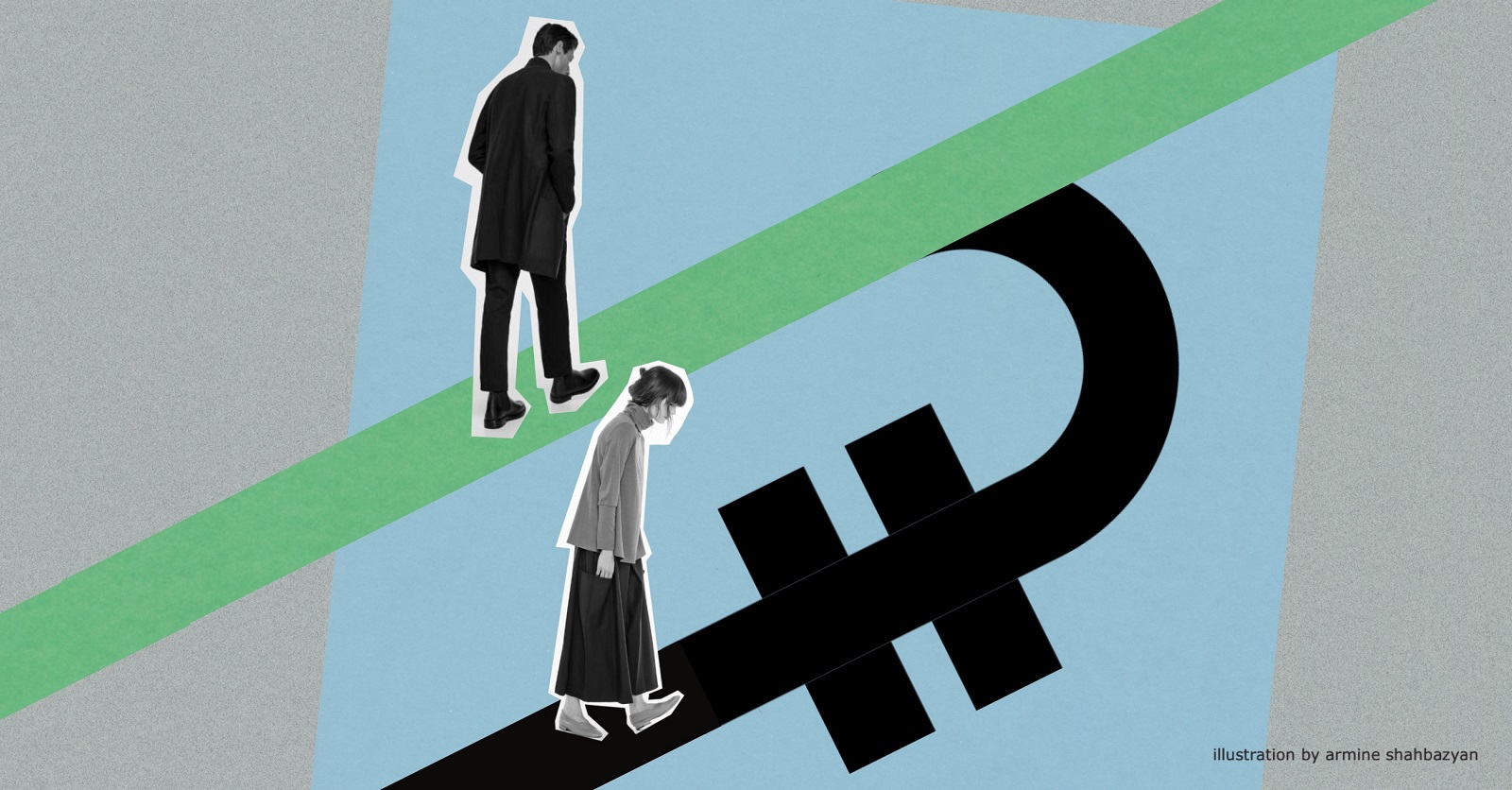
Listen to the article.
Imagine working a full-time job at a company, earning a decent salary. Now, picture a colleague with the same education, skill set and position—yet earning a higher wage. The only difference? Your colleague is a man. This disparity is a manifestation of the gender pay gap, an issue that remains deeply entrenched across the globe.
The World Bank recently released a new report stating that the gender pay gap in Armenia has remained unchanged since 2018, hovering between 25% and 30%. This issue extends beyond Armenia; globally, the gap remains, with Sudan having one of the highest pay gaps and Iceland among the lowest, though no country has yet achieved true equality.
But let’s take a closer look at the situation in Armenia and understand why there even is a gender pay gap and what it needs to get closer to gender pay equality. In her opening address at the launch of the report entitled “Armenia Country Gender Assessment”, World Bank Armenia’s country manager, Carolin Geginat, noted that a possible solution extends beyond governmental policy: “It must be a societal change.”
The data in the report supports her words: Around 90% of Armenian men and 70% of women still believe a woman’s place is at home—a deep-rooted social norm that discourages women’s participation in the workforce. With social attitudes like these, female labor force participation remains low, with fewer than half of working-age women employed. These beliefs don’t just shape individual lives—they actually have an economic impact.
According to Geginat, closing the gender gap isn’t just about equity—it makes financial sense, as pay equity could boost growth and gender balance in the workforce.
When looking at the gender pay gap, it is also crucial to look at the broader gender disparities, which the World Bank does to contextualize pay inequities. Among these broader disparities, the report highlights how Armenian women excel in human capital, with higher educational attainment and longer life expectancy than men.
In 2022, women represented 65.1% of bachelor’s degree enrollments compared to only around 44% for men. The gap becomes even more pronounced at the master’s level, with women’s enrollment nearly double that of men. The World Bank labels this phenomenon a “reverse gender gap,” a trend seen globally but starkly visible in Armenia. The reasons for the male education gap are complex and require more research, the World Bank notes. The main reason among these is that many Armenian men felt they had received enough education, while others cited health concerns or the obligations of mandatory military service.
Even though women have an educational advantage, it has not translated into equivalent workforce participation or wage equality. And despite their academic strides, Armenian women’s education often clusters in traditionally female-oriented fields, such as social work, education, and the arts. For example, 96% of philology students are women, whereas men dominate engineering at 89%. Again, this is likely driven by societal perceptions of women’s competencies—rather than by actual competencies. However, some women are breaking these norms: they now represent a larger share in STEM fields, with an unexpected 54% of math students being female.
But one question remains: Why, with such educational achievements, are Armenian women still lagging in workforce representation and earnings? This disparity—one the World Bank refers to as a persistent “gender pay gap”—has remained consistent in recent years, highlighting the entrenched barriers that women face even as they rise academically.
The primary reason women in Armenia either leave or choose not to enter the labor force is family responsibilities, particularly starting a family. According to the World Bank, having young children (aged 0–5) at home is the leading factor preventing women from participating in the workforce. This is compounded by the fact that women disproportionately shoulder household chores, further restricting their ability to seek employment or pursue careers.
Additionally, the persistent gender pay gap plays a significant role in discouraging women from entering the job market. With women in Armenia earning roughly 30% less than men, the economic incentive to juggle employment and domestic responsibilities diminishes. As a result, the employment rate for women in Armenia remains below 50%, reflecting the structural and societal barriers they face.
That brings us back to deeply rooted social norms. “Social norms affect women’s labor force participation,” the World Bank report underscores. Armenian society still largely supports traditional gender roles. 87% of men and 69% of women believe it is preferable for the man to be the main breadwinner while the woman stays home. These beliefs reinforce the barriers women face and make it challenging to narrow Armenia’s gender and pay gaps.
It’s not all bleak, however. Armenian women are increasingly breaking into high-skill professions, a reflection of their strong educational achievements, as noted by the World Bank. Yet, a significant divide remains. Women continue to be concentrated in lower-paying, traditionally “female” sectors such as education, healthcare, and social work, while men dominate higher-paying industries like construction, defense, and transportation. This disparity underscores persistent gender-based occupational segregation in the workforce.
And once again, the World Bank concludes: “The gaps in employment type and sectors are largely related to social perceptions on the types of activities that are better suited for women” and also “the lack of a complete, supportive family policy”. Which brings us back to women, expected to shoulder the majority of family caregiving, being disadvantaged in employment.
The World Bank notes though that government efforts have made some headway in family support policies, but gaps persist. For example, maternity leave grants 140 days for women but only five days for men, reinforcing traditional roles. Another factor in this equation is affordable childcare, which remains a challenge. 63.8% of Armenian children are not enrolled in childcare programs, especially those under three. High costs, accessibility and quality deter families from using these services, leaving mothers with fewer opportunities to enter the job market.
All these factors—education disparities, traditional caregiving expectations, and limited job support for mothers—create a layered framework that hinders women’s full economic participation. But the consequences go beyond representation alone. These dynamics also directly impact earnings.
According to the World Bank, Armenian women earned just 71% of what men made in hourly wages in 2022, a gap that has remained unchanged since 2018 and that persists regardless of the employment type, the occupation, or the educational level. This gap widens during ages 25-34, a time where most women in Armenia give birth to their first child. This shows how much the gender pay gap seems to be linked to deep-rooted social norms around motherhood and family roles.
As mentioned before, women are often concentrated in lower-paying fields such as education, healthcare or social work, sectors traditionally viewed as more “suitable” or “appropriate” due to deep rooted social norms, which are lower paying jobs in Armenia. This concentration in “female” professions naturally impacts women’s earning potential, placing a considerable share of the gender pay gap within the broader context of occupational segregation.
Another factor which the World Bank considers are the legal frameworks. Armenian law does not guarantee equal pay for work of equal value. Furthermore, remains of Soviet labor policies, which banned women from over 450 professions in fields such as construction, mining, and telecommunications, may still linger in the Armenian workforce today. Although these restrictions were lifted in 2004, the legacy of these limitations likely continues to shape societal expectations around women’s work.
But this doesn’t explain all the remaining pay gaps. The report acknowledges that there are shares that remain unexplained. These include unobserved worker traits such as risk-aversion or preference for negotiation or discrimination.
With these numbers on the table, it’s clear that shifting deeply entrenched social norms is essential to narrowing the gender pay gap. Changing societal beliefs, however, is no small feat—it is a challenge. The World Banks report hasn’t stopped there; it also proposes actionable solutions.
First, eliminating legal differences between men and women is essential—this is a prerequisite for equality in employment in Armenia. Further the World Bank adds: “The legal provision on equal pay needs to be enforced but also improved to mandate equal remuneration for work of equal value.” Additionally, the report advises prohibiting Armenian employers from asking personal questions of applicants to hinder discriminatory practices against mothers or women who plan to have children.
But as emphasized before, policy alone cannot change the current gender pay gap. Shifting social norms and breaking down entrenched stereotypes are equally crucial. The World Bank notes that to create genuine change, efforts must extend into families and communities, aiming to impact attitudes and behaviors relating to women’s work. Another recommendation includes increasing the visibility of women in senior positions, so they can serve as role models.
The World Bank also suggests challenging gender stereotypes from an early age to empower both women and men to explore careers beyond traditional gender-specific occupations and sectors. To shift these deeply rooted beliefs, the report highlights the need for awareness campaigns aimed at educators, policymakers, the media, and the public. Because these influential groups hold the power to reshape social norms.
Realigning these social norms could open the door to a more equal Armenian society. One in which men and women receive equal pay for equal work. But bridging the current gender pay gap will require time as shifting societal beliefs is not an overnight process. The World Bank’s roadmap offers a look into a future of progress, suggesting that over time, these changes could reshape the country’s gender pay gap. And that is a future worth aspiring to.
Also see
Women: The Driving Force in Agriculture
In Armenia's agricultural sector, women take on a more prominent role than men. During the hot summer months, women’s work groups move from region to region, laboring in vast fields from dawn. Their work not only supports their families but also sustains the country’s agricultural resilience.
Read moreThe Feminization of Labor Migration: Women’s Changing Family Roles
Unemployment and financial hardship are pushing Armenian women to seek employment overseas, particularly to the United States and Turkey. Gayane Mkrtchyan addresses the feminization of labor migration, the vulnerability these women face, and the evolving dynamics of Armenian families.
Read moreDeciding to Untie the Knot: Divorce Rates on the Rise
Over the past decade, the number of marriages in Armenia has been decreasing, while divorces are on the rise. Gohar Abrahamyan looks at the psychological, social and financial implications of deciding to untie the knot.
Read moreAddressing Sexual Harassment at the Workplace
Amendments to Armenia’s Labor Code regarding the prohibition of sexual harassment in the workplace, vacation time, internships, employment of minors, and other issues will soon come into effect.
Read moreGifts or Equality? The Gender Gap
Sometimes, a seemingly trivial incident can reflect deep-rooted problems of an entire society. As “Women’s Month” in Armenia comes to an end, Hranoush Dermoyan is reminded of a story that is typical of persisting stereotypes.
Read moreWomen in Tech: Not Enough, Not Yet
No one can refute the success stories and statistics of Armenian women in tech. Taking a more holistic view, however, one finds that the narrative isn’t quite so simple or straightforward.
Read more






